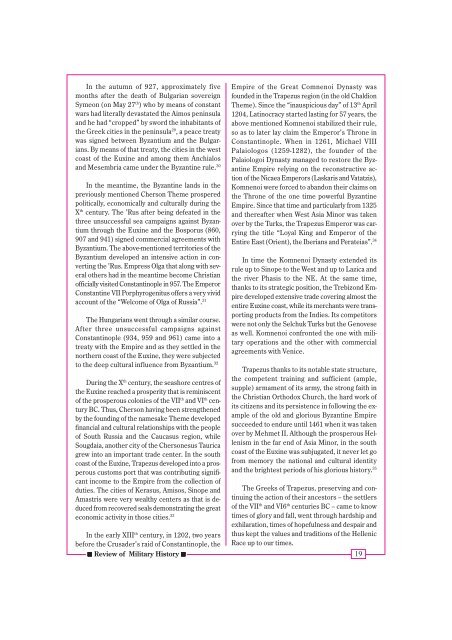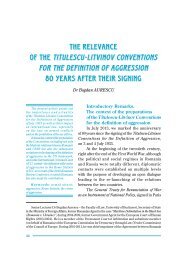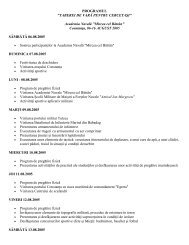Create successful ePaper yourself
Turn your PDF publications into a flip-book with our unique Google optimized e-Paper software.
In the autumn of 927, approximately five<br />
months after the death of Bulgarian sovereign<br />
Symeon (on May 27 th ) who by means of constant<br />
wars had literally devastated the Aimos peninsula<br />
and he had “cropped” by sword the inhabitants of<br />
the Greek cities in the peninsula 29 , a peace treaty<br />
was signed between Byzantium and the Bulgarians.<br />
By means of that treaty, the cities in the west<br />
coast of the Euxine and among them Anchialos<br />
and Mesembria came under the Byzantine rule. 30<br />
In the meantime, the Byzantine lands in the<br />
previously mentioned Cherson Theme prospered<br />
politically, economically and culturally during the<br />
X th century. The ’Rus after being defeated in the<br />
three unsuccessful <strong>sea</strong> campaigns against Byzantium<br />
through the Euxine and the Bosporus (860,<br />
907 and 941) signed commercial agreements with<br />
Byzantium. The above-mentioned territories of the<br />
Byzantium developed an intensive action in converting<br />
the ’Rus. Empress Olga that along with several<br />
others had in the meantime become Christian<br />
officially visited Constantinople in 957. The Emperor<br />
Constantine VII Porphyrogenitus offers a very vivid<br />
account of the “Welcome of Olga of Russia”. 31<br />
The Hungarians went through a similar course.<br />
After three unsuccessful campaigns against<br />
Constantinople (934, 959 and 961) came into a<br />
treaty with the Empire and as they settled in the<br />
northern coast of the Euxine, they were subjected<br />
to the deep cultural influence from Byzantium. 32<br />
During the X th century, the <strong>sea</strong>shore centres of<br />
the Euxine reached a prosperity that is reminiscent<br />
of the prosperous colonies of the VII th and VI th century<br />
BC. Thus, Cherson having been strengthened<br />
by the founding of the namesake Theme developed<br />
financial and cultural relationships with the people<br />
of South Russia and the Caucasus region, while<br />
Sougdaia, another city of the Chersonesus Taurica<br />
grew into an important trade center. In the south<br />
coast of the Euxine, Trapezus developed into a prosperous<br />
customs port that was contributing significant<br />
income to the Empire from the collection of<br />
duties. The cities of Kerasus, Amisos, Sinope and<br />
Amastris were very wealthy centers as that is deduced<br />
from recovered <strong>sea</strong>ls demonstrating the great<br />
economic activity in those cities. 33<br />
In the early XIII th century, in 1202, two years<br />
before the Crusader’s raid of Constantinople, the<br />
����� Review of Military History �����<br />
Empire of the Great Comnenoi Dynasty was<br />
founded in the Trapezus region (in the old Chaldion<br />
Theme). Since the “inauspicious day” of 13 th April<br />
1204, Latinocracy started lasting for 57 years, the<br />
above mentioned Komnenoi stabilized their rule,<br />
so as to later lay claim the Emperor’s Throne in<br />
Constantinople. When in 1261, Michael VIII<br />
Palaiologos (1259-1282), the founder of the<br />
Palaiologoi Dynasty managed to restore the Byzantine<br />
Empire relying on the reconstructive action<br />
of the Nicaea Emperors (Laskaris and Vatatzis),<br />
Komnenoi were forced to abandon their claims on<br />
the Throne of the one time powerful Byzantine<br />
Empire. Since that time and particularly from 1325<br />
and thereafter when West Asia Minor was taken<br />
over by the Turks, the Trapezus Emperor was carrying<br />
the title “Loyal King and Emperor of the<br />
Entire East (Orient), the Iberians and Perateias”. 34<br />
In time the Komnenoi Dynasty extended its<br />
rule up to Sinope to the West and up to Lazica and<br />
the river Phasis to the NE. At the same time,<br />
thanks to its strategic position, the Trebizond Empire<br />
developed extensive trade covering almost the<br />
entire Euxine coast, while its merchants were transporting<br />
products from the Indies. Its competitors<br />
were not only the Selchuk Turks but the Genovese<br />
as well. Komnenoi confronted the one with military<br />
operations and the other with commercial<br />
agreements with Venice.<br />
Trapezus thanks to its notable state structure,<br />
the competent training and sufficient (ample,<br />
supple) armament of its army, the strong faith in<br />
the Christian Orthodox Church, the hard work of<br />
its citizens and its persistence in following the example<br />
of the old and glorious Byzantine Empire<br />
succeeded to endure until 1461 when it was taken<br />
over by Mehmet II. Although the prosperous Hellenism<br />
in the far end of Asia Minor, in the south<br />
coast of the Euxine was subjugated, it never let go<br />
from memory the national and cultural identity<br />
and the brightest periods of his glorious history. 35<br />
The Greeks of Trapezus, preserving and continuing<br />
the action of their ancestors – the settlers<br />
of the VII th and VI6 th centuries BC – came to know<br />
times of glory and fall, went through hardship and<br />
exhilaration, times of hopefulness and despair and<br />
thus kept the values and traditions of the Hellenic<br />
Race up to our times.<br />
19

















